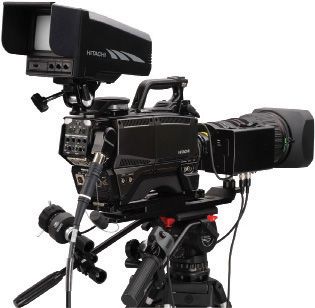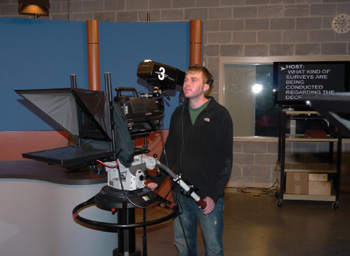The University of North Texas Radio-TV-Film department’s Hitachi cameras are outfitted with Hitachi CU-HD500 camera control units and RU-1000VR remote control panels.University of North Texas Radio-TV-Film students in Denton, Texas, recently used Hitachi Z-HD5000 HDTV studio production cameras to produce three half-hour episodes of an original sitcom, “Peppuccinos.”
The sitcom—created and produced by Noah Sargent while an undergraduate senior in the spring of 2012—takes place in a shop that offers coffee on one side and pizza on the other, hence the name “Peppuccinos.”
Sargent and fellow radio-TV-film students volunteered their time to tackle every aspect of the demanding multi-camera production—including scriptwriting, manning cameras, technical directing, lighting design, audio recording, and music composition. They also had help from UNT theater students who lent their acting talents to bring the project to life while cameras rolled before a small studio audience.
Ease of Use
“This was one of the most ambitious projects we’ve attempted, and the results were impressive. Were it not for the quality of these Hitachi cameras, we probably wouldn’t have attempted this,” said James M. Martin, a senior lecturer at the University of North Texas and technical supervisor of the sitcom. “The Hitachi cameras produced excellent HD image quality, and the students were able to ‘dial in’ the exact look they wanted because the camera shading controls were so easy to use.”
Real World Environment
All six Hitachi cameras—purchased through Hitachi dealer Burst Communications in Houston—are outfitted with Hitachi CU-HD500 camera control units (CCUs) and RU-1000VR remote control panels.
“Producing these sitcom episodes put our students in a realworld, multi-camera television environment where they could really apply and refine the skills they learned in class,” said Martin. Prior to the “Peppuccinos” project, UNT students primarily produced newscasts, such as “The NTTV Nightly News,” a daily, half-hour news report featuring field reports via Skype; elections coverage for broadcast by local cable systems; as well as a Spanish language program. UNT has won several “Lone Star Emmy Awards for Excellence in Student Broadcasting” and other awards.
This student-driven sitcom production maximized UNT’s video facility resources, especially Studio A where the “Peppuccinos” set and risers for up to 35 audience members were constructed. The larger of two UNT studios, Studio A has an adjacent control room that houses a Ross Vision-M 1.5-M/E multi-format switcher, Compix Synergy 2 dual-channel HD graphics system, Blackmagic Design Videohub router, and a 360 Systems HD Max server.
“Since we installed six Hitachi Z-HD5000 HD cameras in 2010, we’ve transitioned to a fully digital, HD-SDI workflow that helps make the most of the high-quality imagery these cameras capture,” Martin said. “As a university facility, we need to stretch our dollars as far as they can go to provide our students with the best possible studio production experience, and Hitachi enables us to do that.”

The three “Peppuccinos” episodes were staged and recorded in one weekend, and that video is being edited by students using Apple Final Cut Pro. When finished, the shows will air on North Texas Television, a local origination channel devoted to UNT programming that is offered by the local Charter cable system, as well as on UNT’s website.
“This was a unique project that brought two UNT departments together—Radio, TV, Film, and Performing Arts,” said Martin who collaborated with UNT Theater Professors Adam Chamberlin and Mario Tooch. “Based on the success of these three episodes, we’re looking forward to offering more multi-camera production projects and classes where students can obtain valuable skills and academic credit. Our goal is to prepare our students for the media jobs of the 21st century by giving them training they can’t get anywhere else.”
Key Elements / / / for the End User
ROI:
“As a university facility, we need to stretch our dollars as far as they can go to provide our students with the best possible studio production experience, and Hitachi enables us to do that.”
—James M. Martin, University of North Texas
Panasonic Video solutions for Campus Production
AG-AC130: Pocket-friendly, great for school sports and campus events (AVCCAM Solid-State Camcorder/ Handheld Model)
Pick-up Device: 1/3 Type Progressive, 2.2Mil Pixels, 3MOS
Effective Pixels: 1920 x 1080
Lens: Panasonic lens with optical image stabilizer, motorized/manual mode switching, 22x zoom, F1.6 - 3.2 (f=3.9mm to 86mm / 35mm equivalent: 28 mm to 616 mm, 16:9)
Filter Diameter: 72 mm
Digital Zoom: 2x / 5x / 10x (to be allocated on USER button, switching by pushing the button)
AC-AC160: Pocket-friendly, and includes intro features for low-end studio production. (AVCCAM Solid-State Camcorder/Handheld Model with HD-SDI Ouput)
Pick-up Device: 1/3 Type Progressive, 2.2Mil Pixels, 3MOS
Effective Pixels: 1920 x 1080
Lens: Panasonic lens with optical image stabilizer, motorized/manual mode switching, 22x zoom, F1.6 - 3.2 (f=3.9mm to 86mm / 35mm equivalent: 28 mm to 616 mm, 16:9)
Digital Zoom: 2x / 5x / 10x (to be allocated on USER button, switching by pushing the button)
Minimum Luminance: 0.4 lx (when F1.6, +30dB of gain, and 1/30 sec. of shutter speed)
Visit www.panasonic.com.










